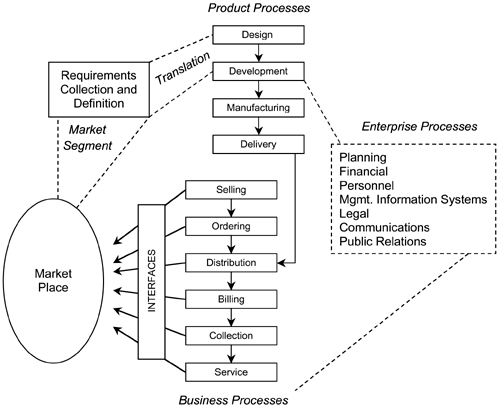Managerial Systems and Processes
Since most of this chapter discusses implementation of managerial systems and processes, and since these terms are often used loosely in business circles, clarification is in order. All work is done through a series of processes. By process we simply mean a sequence of activities that transform inputs (raw materials, information, etc.) into outputs (a finished product, an invoice, etc.). There will always be a process, even if it cannot be seen, and even if it is not standardized. In manufacturing it is easy to see the process—just follow the pipes! Seeing the process is much more difficult in soft areas such as Finance or Legal. Understanding processes is critically important to making any improvement, however, since it is through improvement of the process that we improve outputs. As noted in Chapter 1, process thinking is a fundamental aspect of Six Sigma.
By managerial processes, we mean those that help us manage the organization, as opposed to making, distributing, or selling something. These typically include budgeting, reward and recognition, business planning, and reporting processes. Design and management of these processes generally define the core responsibilities of middle managers. Ideally, these processes help align all employees with strategic direction, such as by communicating or rewarding Six Sigma successes. Poor managerial processes usually produce a dysfunctional organization, while effective managerial processes usually produce an effective and efficient organization.
Figure 5-1 shows a diagram (IBM-Europe [1990]) that illustrates what IBM considers to be its core business processes. The diagram separates the core processes into three major categories: product development and production processes; general business processes, such as sales and marketing; and enterprise processes, the support processes that the customer does not usually see, but that are required to keep the company running. Most of the managerial processes we discuss in this chapter would fall into the category of enterprise processes, although the two other categories also have managerial processes.
Figure 5-1. IBM Core Processes

Often you will need to integrate several processes together to form a system. By system we mean the collection of all relevant processes needed to complete some specific work. For example, your body has a cardio-vascular system that performs the work of circulating blood. The beating of your heart is one process that is part of the cardio-vascular system, but it could not circulate blood effectively without the action of other muscles, or the use of veins and arteries. All muscles, veins and arteries, and other parts of the cardio-vascular system must work in harmony for our blood to properly circulate. To return to the business world, most organizations have an overall reward and recognition system. Annual performance appraisal is typically one process in this system, but there are other processes as well that form an overall system.
An understanding of systems is important because you need to make sure that all processes are properly integrated for overall system optimization. It is common in the business word for people to optimize one process at the expense of others, resulting in poor overall system performance. For example, in a company's sales system four regional managers may compete with each other to land a national account, the net result being a less profitable contract for the company. Each regional manager attempted to optimize his or her regional sales process, but did so to the detriment of the overall corporate sales system. This is called sub-optimization, and has been one of the central themes of management author Peter Senge's work (Senge 1990).
Improving systems can have a profound impact on entire organizations, and will institutionalize change, since systems and their processes define how you do your work. It goes without saying that top talent in leadership roles is required to properly design, implement, and manage these systems.
In the discussion of managerial systems and processes organizations need to change or implement to properly manage Six Sigma deployment, there will undoubtedly be instances where we use the word “system” when the reader feels “process” may be more accurate, and vice versa. This distinction is often gray, rather than black and white. The key point is that we need formal infrastructure, be it a process, a system, or some other mechanism, to effectively manage the effort. The specific term we use is not critical.
The key infrastructure elements are discussed in roughly the order in which they are typically considered in deployment.
